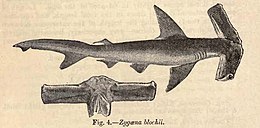丁字雙髻鯊
| 丁字雙髻鯊 | |
|---|---|

| |
| 科學分類 | |
| 界: | 動物界 Animalia |
| 門: | 脊索動物門 Chordata |
| 綱: | 軟骨魚綱 Chondrichthyes |
| 亞類: | 鯊總目 Selachimorpha |
| 目: | 真鯊目 Carcharhiniformes |
| 科: | 雙髻鯊科 Sphyrnidae |
| 屬: | 丁字雙髻鯊屬 Eusphyra Gill, 1862 |
| 種: | 丁字雙髻鯊 E. blochi
|
| 二名法 | |
| Eusphyra blochi (Cuvier, 1816)
| |

| |
| 異名 | |
| |
丁字雙髻鯊又名布氏真雙髻鯊(學名:Eusphyra blochi),為雙髻鯊科丁字雙髻鯊屬下唯一一種。該物種分布於印度、印度尼西亞、澳洲東北部以及南海等海域[1]。丁字雙髻鯊體色為褐色或灰色,身體細瘦,背鰭為鐮刀狀,體長可達186公分。其頭部十分寬大,為錘狀,最寬可達體長的一半。該形態使該魚感官更為敏銳,但其具體演化來源則尚不清楚。丁字雙髻鯊主要生活於印度洋-太平洋海域中部和西部,以硬骨魚、甲殼類和頭足類為食。該魚為胎生物種,一胎會誕下6—25條幼魚不等。其孕期在8至11個月之間,多在2—6月產下幼魚。丁字雙髻鯊對人類基本無害。該魚目前作為食用魚以及魚肝油和魚翅的來源而被大量捕撈,IUCN將其評為「瀕危」。
物種命名
[編輯]荷蘭魚類學家馬庫斯·艾利舍·布洛赫於1785年將一具丁字雙髻鯊標本標註為「錘頭雙髻鯊」(Squalus zygaena)[註 1]1817年,法國博物學家喬治·居維葉在他的著作《作為動物自然歷史基礎和比較解剖學入門的動物界組織分類》[註 2]中指出布洛赫的標本並非錘頭雙髻鯊,而是全新的物種。彼時居維葉將其標註為「z. nob. Blochii」,並未給予其二名法學名。5年後,他的同事阿希爾·瓦朗西安納根據另一具標本詳細描述該物種,給予其學名Zygaena Blochii nobis,並將居維葉歸功為該物種的命名人[2][3]。
1866年,美國魚類學家西奧多·吉爾將丁字雙髻鯊劃至其新建立的丁字雙髻鯊屬Eusphyra。其屬名是古希臘語「εὐ-」(eu-,好的)和「σφῦρα」(sphûra,錘子)的合成詞,不過彼時學界並不認為此物種應當獨立建屬[4][5]。1948年,亨利·布萊恩特·畢格羅和威廉·查爾斯·施洛德爾二人在著作中再次使用該學名。其廣泛使用則要到萊奧納德·康帕格諾於1979和1988年的種系研究發表之後。即便如此,目前仍有學者使用原學名[6]。
種間關係
[編輯]傳統的種系發生學觀點認為雙髻鯊祖先類似於如今真鯊科的祖先,其錘狀頭部在演化過程中不斷增大。按其觀點,頭部形狀最為極端的丁字雙髻鯊應當是最晚出現的雙髻鯊。然而,對其同工酶、粒線體DNA和核DNA的分析給出的結論與傳統觀點恰恰相反,丁字雙髻鯊實際上是雙髻鯊中最為基幹的一種,其頭部的演化反而有不斷縮小的趨勢。此外,該發現亦支援分立丁字雙髻鯊屬以讓雙髻鯊屬成為單系群。從目前的資訊來看,丁字雙髻鯊大概在1500—2000萬年前的中新世與其他雙髻鯊分離[6][7][8]
| |||||||||||||||||||||||||||||||||||||||||||||
| 根據分子種系發生學證據繪製的雙髻鯊支序圖[7] |
外貌描述
[編輯]
丁字雙髻鯊頭部呈錘狀,兩側長而窄,略向後彎曲,前部中間有一道輕微凹陷。此結構名為「頭翼」[9],寬度約是其體長的40—50%。丁字雙髻鯊的鼻孔寬度可達其嘴寬的兩倍,幾乎占據整個頭翼前端,前端還各有一個小凸起。該魚雙眼位於頭翼末端,長有瞬膜。其嘴較小,呈弧狀,上顎有15—16顆牙齒,下顎則是14顆。此外,其上下顎中間可能會長有一排小牙齒,丁字雙髻鯊牙齒小而圓,唯尖端是鋒利的三角形。丁字雙髻鯊合有鰓裂五對,其中第五對位於第一對背鰭最前端[10][3][11][12]

丁字雙髻鯊身體細長,呈流線型。其第一對背鰭十分高而窄,形似鐮刀;第二對背鰭則要小得多,最前端約位於臀鰭後三分之一處。該魚臀鰭尺寸約為其第二對背鰭的一半。丁字雙髻鯊胸鰭較小,大概位於其第一對背鰭最前端。其尾柄上半部大於下半部,且上半部末端和根部均有一道凹槽[10][11]。該魚全身均覆蓋有三棱形的鱗片,其鱗片尖端均朝向前方[10]。丁字雙髻鯊最大可長到1.9公尺[11]。
生態與習性
[編輯]丁字雙髻鯊多於海床上方覓食,其獵物主要為小型硬骨魚,亦會捕食頭足類和甲殼類[10][13]。
生命週期
[編輯]同其他雙髻鯊一樣,丁字雙髻鯊是胎生動物。胚胎會在母魚體內發育,透過胚胎取得養分及代謝廢物。成年雌性丁字雙髻鯊僅有一個功能正常的卵巢,位於其身體右側,但其兩側子宮均功能正常。該魚孕期子宮內部會長出隔層以分隔胚胎。孟買附近海域族群的繁殖季為每年7—8月的季風季[14]。在交配前,雄魚會齧咬雌魚以示愛。雌魚每年均會繁殖,其一胎可產下6—25條幼魚,且越大的雌性一般會產下更多的幼魚。在印度水域該魚的孕期為8—9個月,澳大利亞附近水域則是10—11個月[10][13][15]。懷孕的雌性可能會彼此爭鬥[3]。
胚胎初始會從卵黃處取得養分,且發育大體上類似其他鯊魚。當胚胎發育至4—4.5公分時會長出魚鰭和頭翼。長至12—16公分時,其卵黃中的營養會耗盡,且卵黃囊和子宮壁上會出現褶皺以備之後連結形成胎盤。彼時胚胎已與成魚非常相似,但各器官仍不成熟,也未長出色素。其頭翼向後折起,鰓裂外有長長的鰓絲。幼鯊長至20—29公分時會形成胎盤,彼時還會長出牙齒和鱗片,外觀開始著色,其鰓絲也已變小。在長至30公分時,除去體型外其外貌已十分類似於成年個體[14][15]。
在孟買和帕朗格伊佩泰附近海域,雌魚會在每年5—6月誕下幼魚,在馬納爾灣是3—4月,而在澳大利亞北部海域則是2—3月。新生幼魚的尾巴先離開母體,而其頭翼則會一直到完全誕生後才展開,以免阻塞母魚的泄殖腔[13][14][15]。剛誕生的幼魚體長32—47公分[11]。雄性丁字雙髻鯊在長到1.0—1.1公尺時性成熟,雌性則是1.1—1.2公尺[11][15]。其最長壽命至少為21年[16]。
寄生蟲
[編輯]丁字雙髻鯊的寄生蟲包括絛蟲Callitetrarhynchus blochii[17]、Heteronybelinia heteromorphi[18]、Otobothrium carcharidis、O. mugilis[19]、Phoreiobothrium puriensis[20]、Phyllobothrium blochii[21];線蟲Hysterothylacium ganeshi[22]、Pseudanisakis屬[23]、Raphidascaroides blochii[24]和Terranova屬[23];橈腳類Caligus furcisetifer[25]和原蟲Eimeria zygaenae[26]。
頭翼演化
[編輯]丁字雙髻鯊的頭翼有助於強化其感官,如該魚雙眼視場可廣至48°,四倍於一般真鯊類,因此其景深感知能力出色,或有助於其捕獵[27]。其頭翼上極長的鼻孔也使丁字雙髻鯊擁有大量嗅覺受器,便於其感知水中的氣味。一條1公尺長的丁字雙髻鯊每分鐘可透過嗅覺檢測2300毫升的海水。此外,該頭部結構使其兩側鼻孔距離較遠,利於其尋味定位[28]。最後,這一結構還令丁字雙髻鯊的勞倫氏壺腹和側線表面積更大,強化了該魚感受電場的能力[3]。不過,丁字雙髻鯊的頭翼大小過於誇張,並不能同其他雙髻鯊的頭翼一樣提升其機動性[29]。
保育情況
[編輯]丁字雙髻鯊對人類無害。目前其分布範圍內對該魚的捕撈活動頻繁。其魚肉可直接在市場上出售,肝臟可製成魚肝油,魚鰭可作為魚翅出口至東亞,而下水則可製成魚食[3][10]。泰國灣等東南亞水域的捕魚尤為頻繁,加之其賴以生存的紅樹林棲息地被破壞,丁字雙髻鯊的族群在過去三代內下降了至少50%,IUCN將其評為為「瀕危」。然而,澳大利亞北部水域的族群面臨的漁業壓力極小,短時間內無滅絕之虞[1]。
注釋
[編輯]參考文獻
[編輯]- ^ 1.0 1.1 1.2 Smart, J.J.; Simpfendorfer, C. Eusphyra blochii. The IUCN Red List of Threatened Species. 2016, 2016: e.T41810A68623209 [19 November 2021]. doi:10.2305/IUCN.UK.2016-1.RLTS.T41810A68623209.en
 .
.
- ^ Cuvier, G. Le Règne Animal distribué d'après son organisation pour servir de base à l'histoire naturelle des animaux et d'introduction à l'anatomie comparée. Deterville. 1816: 127.
- ^ 3.0 3.1 3.2 3.3 3.4 Compagno, L.J.V. Sharks of the World: An Annotated and Illustrated Catalogue of Shark Species Known to Date. Food and Agricultural Organization of the United Nations. 1984: 540–541. ISBN 978-9251013847.
- ^ Gill, T.N. Analytical synopsis of the order of Squali; and revision of the nomenclature of the genera. Annals of the Lyceum of Natural History of New York. 1862, 7: 371–408. doi:10.1111/j.1749-6632.1862.tb00166.x.
- ^ Froese, R.; Pauly, D. (編). Eusphyra blochii, Winghead shark. FishBase. 2011 [2013-05-18]. (原始內容存檔於2022-10-06).
- ^ 6.0 6.1 Martin, R.A. Recent Changes in Hammerhead Taxonomy. ReefQuest Centre for Shark Research. 1998 [2013-05-18]. (原始內容存檔於2020-01-26).
- ^ 7.0 7.1 Lim, D.D.; Motta, P.; Mara, K.; Martin, A.P. Phylogeny of hammerhead sharks (Family Sphyrnidae) inferred from mitochondrial and nuclear genes. Molecular Phylogenetics and Evolution. 2010, 55 (2): 572–579. PMID 20138218. doi:10.1016/j.ympev.2010.01.037.
- ^ Cavalcanti, M.J. A phylogenetic supertree of the hammerhead sharks (Carcharhiniformes: Sphyrnidae). Zoological Studies. 2007, 46 (1): 6–11.
- ^ 友義 (編). 双髻鲨的头为什么长得像锤子. BBC. 2015-12-23 [2023-08-06]. (原始內容存檔於2023-08-06).
- ^ 10.0 10.1 10.2 10.3 10.4 10.5 Last, P.R.; Stevens, J.D. Sharks and Rays of Australia second. Harvard University Press. 2009: 288. ISBN 978-0674034112.
- ^ 11.0 11.1 11.2 11.3 11.4 Last, P.R.; White, W.T.; Caire, J.N.; Dharmadi; Fahmi; Jensen, K.; Lim, A.P.F.; Manjaji-Matsumoto, B.M.; Naylor, G.J.P.; Pogonoski, J.J.; Stevens, J.D.; Yearsley, G.K. Sharks and Rays of Borneo. CSIRO Publishing. 2010: 134–135. ISBN 978-1-921605-59-8.
- ^ Randall, J.E. Coastal Fishes of Oman. University of Hawaii Press. 1995: 38. ISBN 978-0824818081.
- ^ 13.0 13.1 13.2 Stevens, J.D.; Lyle, J.M. Biology of three hammerhead sharks (Eusphyra blochii, Sphyrna mokarran and S. lewini) from Northern Australia. Australian Journal of Marine and Freshwater Research. 1989, 40 (2): 129–146. doi:10.1071/MF9890129.
- ^ 14.0 14.1 14.2 Appukuttan, K.K. Studies on the developmental stages of hammerhead shark Sphyrna (Eusphyrna) blochii from the Gulf of Mannar (PDF). Indian Journal of Fisheries. 1978, 25 (1–2): 41–52 [2023-08-07]. (原始內容存檔 (PDF)於2022-05-19).
- ^ 15.0 15.1 15.2 15.3 Devadoss, P. Observations on the breeding and development of some sharks. Journal of the Marine Biological Association of India. 1988, 30 (1–2): 121–131 [2023-08-07]. (原始內容存檔於2014-10-12).
- ^ Smart, J.J.; Harry, A.V.; Tobin, A.J.; Simpfendorfer, C.A. Overcoming the constraints of low sample sizes to produce age and growth data for rare or threatened sharks. Aquatic Conservation: Marine and Freshwater Ecosystems. 2012, 23 (1): 124–134. doi:10.1002/aqc.2274.
- ^ Pramanik, P.B.; Manna, B. Callitetrarhynchus blochii new species (Cestoidea: Lacistorhynchidae) from Sphyrna blochii Cuvier, 1817 from Bay of Bengal at Digha coast, India. Journal of Natural History. 2006, 2 (2): 10–15.
- ^ Palm, H.W. Nybelinia Poche, 1926, Heteronybelinia gen. nov. and Myxonebelinia gen. nov. (Cestoda: Trypanorhyncha) in the collections of The Natural History Museum, London. Bulletin of the Natural History Museum. Zoology Series (London). 1999, 65 (2): 133–153.
- ^ Schaeffner, B.C.; Beveridge, I. Redescriptions and new records of species of Otobothrium Linton, 1890 (Cestoda: Trypanorhyncha). Systematic Parasitology. 2013, 84 (1): 17–55. PMID 23263940. S2CID 18892377. doi:10.1007/s11230-012-9388-1. hdl:11343/282767
 .
.
- ^ Srivastav, A.K.; Capoor, V.N. On a new cestode, Phoreiobothrium puriensis n. sp. Indian Journal of Helminthology. 1982, 34 (1–2): 82–85.
- ^ Srivastav, A.K.; Srivastava, B.K. On a new cestode, Phyllobothrium blochii sp. n. (Phyllobothriidae, Cestoda) from the elasmobranch fish, Zygaena blochii (Cuvier) (Carchariidae, Euselachii) from Puri, Orissa (India). Helminthologia. 1988, 25: 89–94.
- ^ Lakshmi, I.R.; Sreeramulu, K. Hysterothylacium ganeshi n. sp (Nematoda-Anisakidae) from the intestine of Shark, Sphyrna blochii (Cuvier). Geobios (Jodhpur). 2007, 34 (1): 29.
- ^ 23.0 23.1 Arthur, J.J.R.; Ahmed, A.T.A. Checklist of the Parasites of Fishes of Bangladesh (FAO Fisheries Technical Paper 369/1). Food and Agriculture Organization of the United Nations. 2002: 44. ISBN 978-9251048542.
- ^ Bruce, N.L.; Cannon, L.R.G.; Adlard, R. Synoptic checklist of ascaridoid parasites (Nematoda) from fish hosts. Invertebrate Taxonomy. 1994, 8 (3): 583–674. doi:10.1071/IT9940583.
- ^ Margolis, L.; Kabata, Z.; Parker, R.R. Catalogue and synopsis of Caligus, a genus of Copepoda (Crustacea) parasitic on fishes. Bulletin of the Fisheries Research Board of Canada. 1975, 192: 1–117.
- ^ Chakravarty, M.; Mandal, A.K. A new coccidium, Eimeria zygaenae n. sp. from hammer headed shark, Zygaena blochii. Proceedings of the 48th Indian Science Congress (Roorkee). 1961, (Part III): abstract 93.
- ^ McComb, D.M.; Tricas, T.C.; Kajiura, S.M. Enhanced visual fields in hammerhead sharks. Journal of Experimental Biology. 2009, 212 (24): 4010–4018. PMID 19946079. doi:10.1242/jeb.032615
 .
.
- ^ Kajiura, S.M.; Forni, J.B.; Summers, A.P. Olfactory morphology of carcharhinid and sphyrnid sharks: Does the cephalofoil confer a sensory advantage?. Journal of Morphology. 2005, 264 (3): 253–263. CiteSeerX 10.1.1.547.477
 . PMID 15549717. S2CID 6841608. doi:10.1002/jmor.10208.
. PMID 15549717. S2CID 6841608. doi:10.1002/jmor.10208.
- ^ Nakaya, K. Hydrodynamic function of the head in the hammerhead sharks (Elasmobranchii: Sphyrnidae). Copeia. 1995, 1995 (2): 330–336. JSTOR 1446895. doi:10.2307/1446895.

